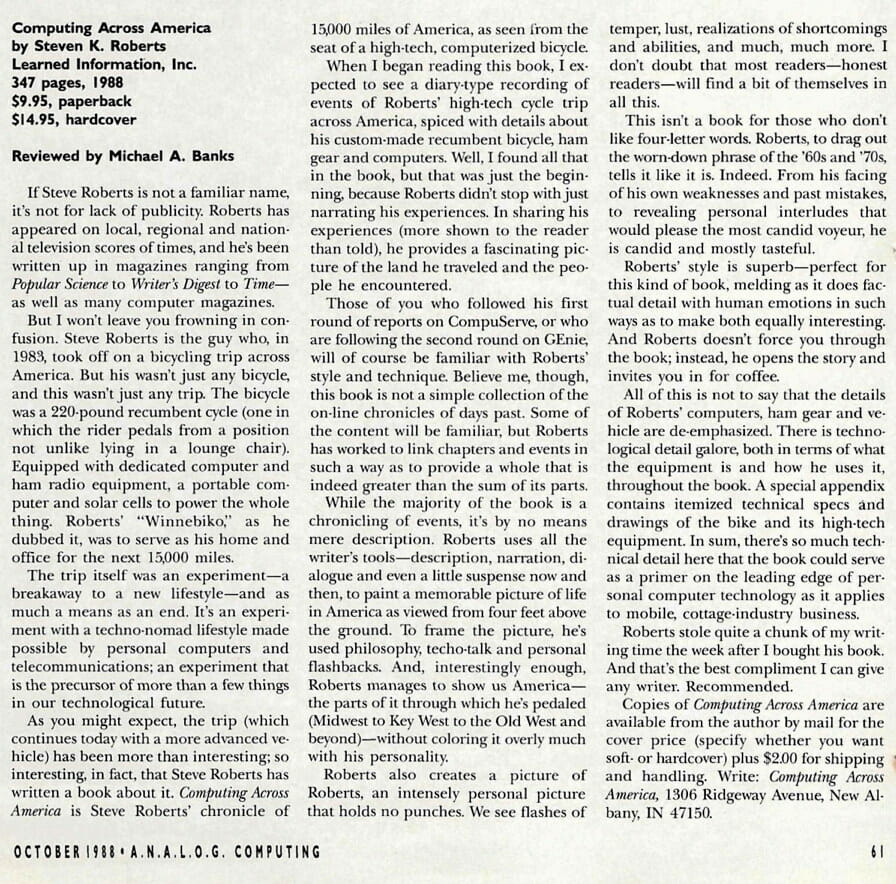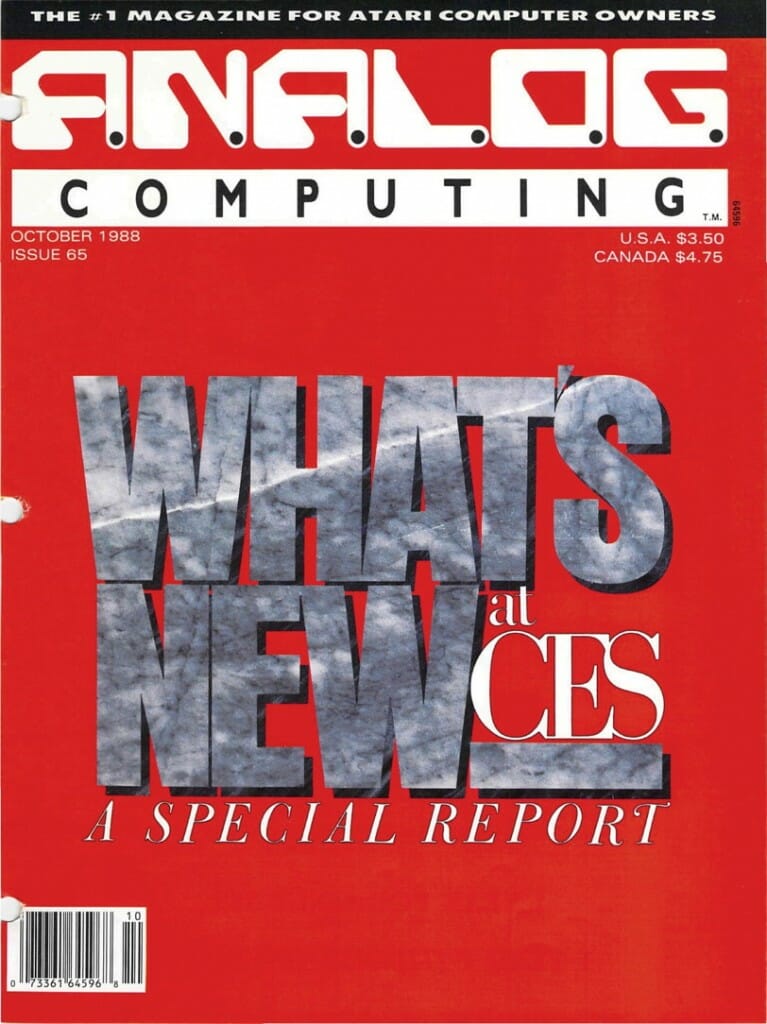
Computing Across America book review – A.N.A.L.O.G. Computing
I find this review most gratifying, and not only because the reviewer enjoyed my book. Michael A. Banks is a writer I’ve known and respected for years, and his Modem Reference was one of the most-thumbed technical books on my shelf… back before USB <creak>. He was a prolific columnist in the early days of personal computing publishing, and knew well the context from which he speaks in this review. It reminds me to get off my duff and re-issue this book…
I have never owned an Atari, but A.N.A.L.O.G. Computing magazine was the big one in the industry.
by Michael A. Banks
A.N.A.L.O.G. Computing
October, 1988
If Steve Roberts is not a familiar name, it’s not for lack of publicity. Roberts has appeared on local, regional and national television scores of times, and he’s been written up in magazines ranging from Popular Science to Writer’s Digest to Time — as well as many computer magazines.
But I won’t leave you frowning in confusion. Steve Roberts is the guy who, in 1983, took off on a bicycling trip across America. But his wasn’t just any bicycle, and this wasn’t just any trip. The bicycle was a 220-pound recumbent cycle (one in which the rider pedals from a position not unlike lying in a lounge chair). Equipped with dedicated computer and ham radio equipment, a portable computer and solar cells to power the whole thing. Roberts’ “Winnebiko,” as he dubbed it, was to serve as his home and office for the next 15,000 miles.
The trip itself was an experiment — a breakaway to a new lifestyle — and as much a means as an end. It’s an experiment with a techno-nomad lifestyle made possible by personal computers and telecommunications; an experiment that is the precursor of more than a few things in our technological future.
As you might expect, the trip (which continues today with a more advanced vehicle) has been more than interesting; so interesting, in fact, that Steve Roberts has written a book about it. Computing Across America is Steve Roberts’ chronicle of 15,000 miles of America, as seen from the seat of a high-tech, computerized bicycle.
When I began reading this book, I expected to see a diary-type recording of events of Roberts’ high-tech cycle trip across America, spiced with details about his custom-made recumbent bicycle, ham gear and computers. Well, I found all that in the book, but that was just the beginning, because Roberts didn’t stop with just narrating his experiences. In sharing his experiences (more shown to the reader than told), he provides a fascinating picture of the land he traveled and the people he encountered.
Those of you who followed his first round of reports on CompuServe, or who are following the second round on GEnie, will of course be familiar with Roberts’ style and technique. Believe me, though, this book is not a simple collection of the on-line chronicles of days past. Some of the content will be familiar, but Roberts has worked to link chapters and events in such a way as to provide a whole that is indeed greater than the sum of its parts.
While the majority of the book is a chronicling of events, it’s by no means mere description. Roberts uses all the writer’s tools — description, narration, dialogue and even a little suspense now and then, to paint a memorable picture of life in America as viewed from four feet above the ground. To frame the picture, he’s used philosophy, techo-talk and personal flashbacks. And, interestingly enough, Roberts manages to show us America — the parts of it through which he’s pedaled (Midwest to Key West to the Old West and beyond) — without coloring it overly much with his personality.
Roberts also creates a picture of Roberts, an intensely personal picture that holds no punches. We see flashes of temper, lust, realizations of shortcomings and abilities, and much, much more. I don’t doubt that most readers — honest readers — will find a bit of themselves in all this.
This isn’t a book for those who don’t like four-letter words. Roberts, to drag out the worn-down phrase of the ’60s and ’70s, tells it like it is. Indeed. From his facing of his own weaknesses and past mistakes, to revealing personal interludes that would please the most candid voyeur, he is candid and mostly tasteful.
Roberts’ style is superb — perfect for this kind of book, melding as it does factual detail with human emotions in such ways as to make both equally interesting. And Roberts doesn’t force you through the book; instead, he opens the story and invites you in for coffee.
All of this is not to say that the details of Roberts’ computers, ham gear and vehicle are de-emphasized. There is technological detail galore, both in terms of what the equipment is and how he uses it, throughout the book. A special appendix contains itemized technical specs and drawings of the bike and its high-tech equipment. In sum, there’s so much technical detail here that the book could serve as a primer on the leading edge of personal computer technology as it applies to mobile, cottage-industry business.
Roberts stole quite a chunk of my writing time the week after I bought his book. And that’s the best compliment I can give any writer. Recommended.
Copies of Computing Across America are available from the author by mail for the cover price [obsolete details redacted]




You must be logged in to post a comment.